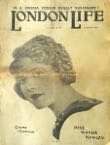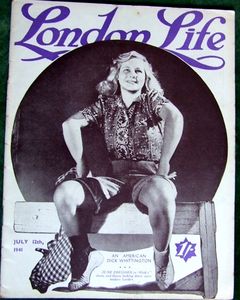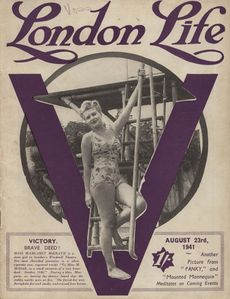London Life
london-life-magazine-1920-11nov-6-no43.jpg
| ||||||||||
London Life: 1920--1950
Between the 1920s and the early 1950s the publication London Life appeared weekly as a 'glamour' magazine; and through changing fashions always had showgirls or 'bathing belles' on its covers and similar frivolities in its pages. However, its contents combined a consistent and respectable variety of topical chat, theatrical and film news and some very mildly titillating light fiction, articles, cryptic 'agony aunt' advice, cartoons, and astrology. The readers' letters section grew steadily, seemingly particularly stimulated by the racier elements of some of the articles and stories.
By present standards topics like Night Attire in Foreign lands or Lady Wrestlers of Olden Times would be treated in an entirely coy and innocent way, matched by the style of line and half-tone drawings of very variable quality. In the 1930s some readers began to illustrate their letters with photographs of their girlfriends variously dressed in rubber capes and extraordinary footwear, their effect now seeming rather touchingly comic and artless.
Claims for the acceptability of London Life might be supported by its growth to a late 'thirties heyday when occasional 60 page celebratory issues were embellished with tasteful 'Art supplements' which included regular choices from the Royal Academy's summer exhibition nude studies. About twice a year during this period they produced their massive 120 page 'special issues' jammed with innumerable letters from readers and six to eight stories as well.
However, at a shilling (5p) a copy, one and sixpence (7.5p) for larger issues, and two and sixpence (12.5p) for really big ones, it was perhaps rather expensive in comparison with much more illustrious and better produced contemporaries such as the Strand Magazine, suggesting a rather dubious circulation, and reputation.
A significant possible indication of social worth, the wartime allocation of paper allowed to the Strand Magazine was a comparatively luxurious 96 pages in the mid-forties, copious advertising for tobacco, soap, and many everyday products that had become scarcely unobtainable for civilian purchase, and a full-colour cover. London Life had been reduced to an innocuously bland and tiny pamphlet a year or two earlier. All the interesting aspects had vanished, the stories became much rarer and what was left was mostly hints and tips about how to make the best of wartime shortages, coupled with some rather unconvincing 'keep cheerful' type propaganda.
Though London Life survived until the 1950s (just), it might be characterised as a lingering civilian war-victim bereft of its once robust personality. Its Fleet Street premises had been destroyed by a direct hit in December 1940, late in the first German air-campaign known as the Blitz, and all its distinctive hoard of records and back-numbers were lost. From a new address in the Thames valley it soldiered on, making telling appeals for long-established readers to contribute old issues to the archives. The magazine had long relied on the re-use of some material, and its flow of original pieces, particularly art-work declined noticeably. Only the peculiar vigour of its letter pages flourished anew until near extinction came in the autumn of 1941.
- London Life magazine covers
Sampled over 50 years later, quite the most intriguing and now irrecoverable flavour of London Life was the regular reference to the attractions of limbless and lame women. At intervals over several years from 1927, a writer named Wallace Stort contributed lengthy, sometimes serialised stories whose heroines were always young beautiful spirited creatures who moved in an implausible theatrical world of limbless girls and their admirers.
A probably less than enthusiastic lady artist provided most of the rather vapid illustrations of a demi-monde where young women rest contentedly on chaise-longues, their delicately chaste gowns revealing fewer limbs than even the heroine possesses. She is in every scene, in and out of the boudoir, resting or sweetly poised on her one dainty leg. Even when she is obliged to toy with an equally dainty crutch, it leaves her hand invitingly free for dalliance with a clean-cut (and unimpaired) hero.
The author of these fantasies went on to respond to 'interested readers' by contributing both articles and letters insistently claiming the authenticity of his stories and his settings, which 'some years ago on the Continent' had been the background to his own ideal marriage. It was natural that he could recall it so well because the wife he had met, wooed, and won there was an irresistibly graceful beauty and he adored her to the ground beneath her ethereally light little foot. Since then, together they had formed the inspirational nucleus of a constantly growing circle of exclusively limbless and fascinating young women, all described in a manner indistinguishable from the Wallace Stort fiction.
Even a reader interested in the subject matter and with a taste for the 1930-ish period charm might find the stories tiresomely dated and unreal. Yet it certainly appeared that Mr Stort's work met with lasting demand. One or two of his stories were republished by the magazine after intervals of many years. Every few weeks letters referring to Wallace Stort's subject matter appeared in the correspondence pages of London Life, which more commonly dealt with curious preferences in dress, the finer points of women's mud wrestling, and blustery rebukes to Mounted Mannequin for her use of spurs. The word monopede (Later to be resurrected in Penthouse and Forum) may have been coined in the magazine and it must have been such frankly close interest in the condition that fostered a regular correspondence, some letters being undoubted pot-boilers, but many others being surely too naïvely transparent fantasies to be dismissed as direct editorial creations.
Typically the letters purported to be from exuberantly vain 'one-legged girls' eager to describe their 'slim and gleaming black crutches' and their single 'slender silk-clad' legs, and 'four inch heeled' shoes. Sometimes these imaginative but patchily researched confessions were accompanied by clumsy 'sketches of myself'. A somewhat more sophisticated regular correspondent sent supposedly relaxed indoor photographs showing his wife with a pair of crutches, but when her face was visible never commented on her glum expression. It strongly suggested the mental and physical demands on the baffled woman posing with one leg concealed beneath her dress.
Perhaps just once or twice a year would a conceivably genuine letter from a woman, a husband, or boy-friend discuss such disablement, rather more often the frank confessions of ineffectually fascinated males, but very rarely indeed a smudgy Kodak Brownie snap showed a one-legged woman accepting such admiration. One reader's notably affectionate but matter-of-fact letter described 'a girl-friend of mine who had her leg off six years ago' and how cheerfully she had agreed to stop and pose for a snapshot astride her bicycle.
His little photo shows an appealing, pleasantly-smiling young woman wearing a 1930s cardigan and cotton dress, and demonstrating true patience with her gentleman friend. She held the brakes of her bike, put her foot up on the pedal and made it look no trouble at all to perch on two wheels and a severely functional wooden leg. (All contributions on the theme faced the possibility of healthy criticism and it was not uncommon for knowledgeable correspondents to carp about little technical discrepancies to be spotted in letter from people who assumed such names as 'One-Shoe-Prue', 'Husband of one leg', and 'Short leg Sally'. Even the carefree cyclist and her plain spoken admirer were challenged by an envious enthusiast. He, clearly coveting a girl friend with such physical qualities, could not resist casting doubt on the depth of her friend's acquaintance with her in writing that she had NEVER 'been on crutches'.
One or two plaintive letters from men inquired whether there were ladies who found limbless males especially attractive, but no response emerged. Even a theatrical photograph of a dapper American singer with a jaunty matched peg-leg strapped over his white stage suit failed to arouse confessions of fluttered hearts.
One or two of Wallace Stort's novelettes featured a one-legged young man in some extremely marginal rôle, allowing the contrivance in which the heroine cross-dresses, but correspondence page students of the writer ignored this seam of development.
Though there were some rare grains of persuasive evidence that real-life limb-deficient ladies might favour some of their particular admirers, another allied connoisseur-ship never did see their ideally endowed women portrayed by a professional writer or artist, nor even an amateur photographer. Every so often letters describing the special charm of women who insouciantly glamorized the need to augment a short leg.
An appropriate tradition of craftsmanship and fashion had for centuries raised not only milkmaids above the farmyard on iron pattens, but ladies strolled the drenched piazzas of Florence on chopines of elegantly carved wood and colored leather. But those women who could afford to disdain the purely functional thick-soled boot and commissioned more aesthetically refined orthopedic work evidently did not care for wider appreciation of their fastidious taste.
It was odd that not one such lady reader was ever persuaded to pose for a London Life-reading friend. A number of readers enjoying (as their monopede cousins did), suspiciously jolly and descriptive pen-names, claimed personal experience confirming that a well-shaped Gothic arch of sole and heel made ladies' orthopedic work alluring and pleasurable to wear. A few drawings of their useful and subtly shaped footwear were attempted by mostly very amateurish artist-admirers, but, without explanation, the lady owners were never portrayed, even partially. (Such ladies and their admirers were perhaps more likely to be brought together by distaste for a long-standing landmark in the advertising pages of the impeccably gentlemanly Strand Magazine. In a curious parallel to London Life's loyal and enduringly fetishy advertiser of ladies' shoes in men’s' sizes, Strand carried a comparably eye-catching little display, a primitively derisive example of knocking copy unchanged for 30 or 40 years. A blotchy old drawing showed a spider's web entangling a jumble of orthopedic boots and clumsily emphatic letters forming the message 'Thing of the past!! UNSIGHTLY HIGH BOOTS ABOLISHED.'
The relentless rise of post-Edwardian women's hemlines would eventually expose all but the most extremely elevated patent extension as a cosmetically formed boot over which a normal shoe could be fitted. Only unladylike trousers could reliably conceal the appliance. Glimpses of this commercially inspired repugnance for their cheaper but effective aids must have offended the sensibilities of generations of lame women and their few and even more hopelessly shy admirers. Very recently a famously brash television front-person memorialized a gallant rearguard as 'those little old ladies you used to see with one leg shorter than the other'. (His comment was inspired by a designer, who like Ms Westwood, may yet revive the fortunes of artistically heightened footwear.)
It may be that a financially sound backer with unusual tastes served his own special interests through persistent support for an occasionally seedy old magazine and its more curious contents, yet it did at least perhaps incidentally reassure some people in their misfortunes. Its readers lived near the end of an era in which country and Christianity were still what are known now as valid concepts.
The common sight of war-wounded and undisguised disabled people sustained a perception that was at one sobering and traditionally accepted, that physical misfortune might lie in wait for everyone. (Some statistically corrected number-crunching has suggested that 1930s road traffic actually more dangerous to life and limbs than today's terrifying masses of ram-raiders, and company-car persons crazed by the dull thuds and bleeps of the in-car stereos and telephones.)
In the later 1940s the Welfare State came into existence. Advertisements for false legs and cork boots vanished overnight. Did our one-armed postman on his bike, or the one-legged mother of a successful businessman's large family believe a 'free' artificial limb would improve their lives? If they foresaw that they might become anachronistic bogey-figures they did not seem to care very much. Up to that time a sophisticated artificial limb could cost several months wages, and many people of their generation had learned to appear almost perfectly comfortable without such things.
Some of the more informative letters in London Life had made readers aware of the financial as well as the everyday technical, physiological, and aesthetic deterrents to cosmetic limb ownership, but the great majority of people remained no more than passingly curious about the owner of a pair of crutches or an empty sleeve. Such details would not in themselves be attributes of either poverty of willful eccentricity. The everyday sight of a few such people on buses, in shops, cafés, offices, and theaters was reassurance that misfortune was manageable and whatever aids were used were not merely socially acceptable, but deserved considerate respect rather than squeamish avoidance. Even if sometimes artlessly expressed, the editorial policy of London Life should surely be allowed the benefit of any doubts about its enlightenment. For the price of a seat at the pictures a copy might arouse not only discussion of the perfected charms enjoyed by actresses and film stars, but of the physically imperfect on the bus ride home.
Over fifty years progress some remoter aspects of romance have become clouded, some subtle liberality have become lost, and certainly new pruderies have been discovered since nineteen thirty-something. Seen amid today's complacency lascivious entertainments, the interminable drone of 'caring' chat-shows and the unsociable plague of mass motor culture, London Life of 50 years ago does look gauche and quaint, yet it gives a tantalizingly distant reflection of a society that could be generous without being affluent. Unlike today's 'proud' new self-declared minorities, the lame then had few lobbyists, but could point to a somewhat confused but regular and truly spontaneous attraction to them expressed in a quite innocently popular magazine.
See also [ London Life 02 ]
External links
http://www.magforum.com/londonlifeindex.htm
Chat rooms • What links here • Copyright info • Contact information • Category:Root


